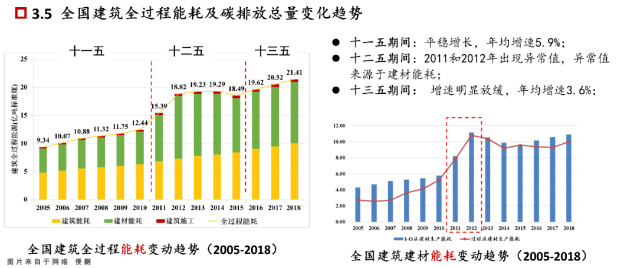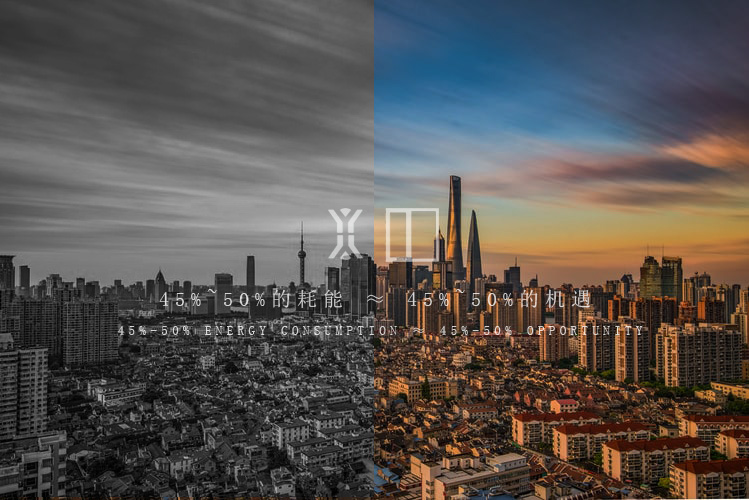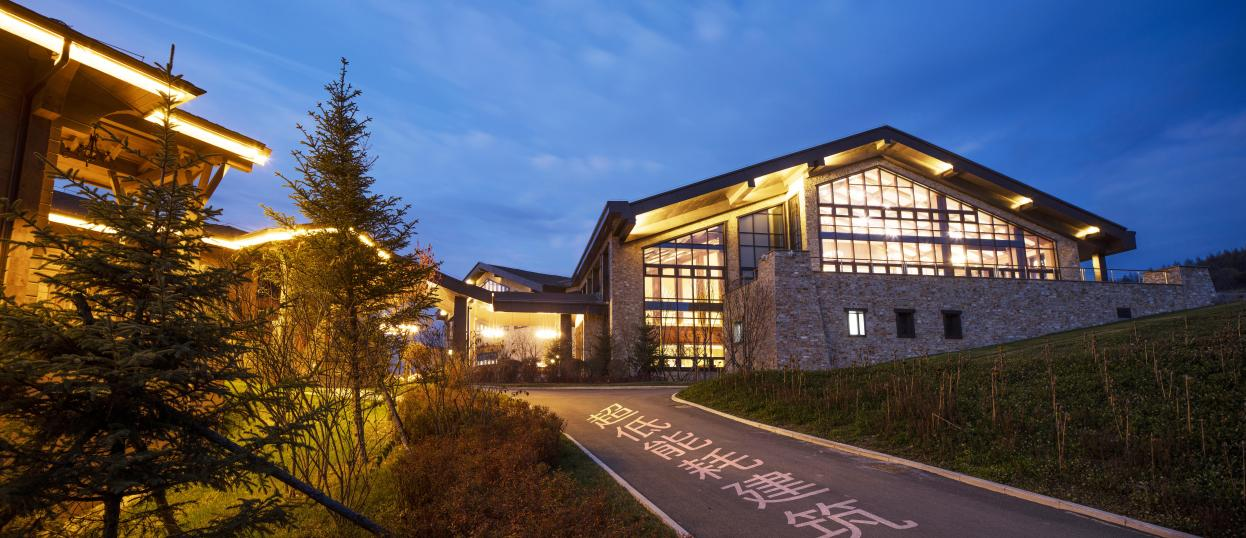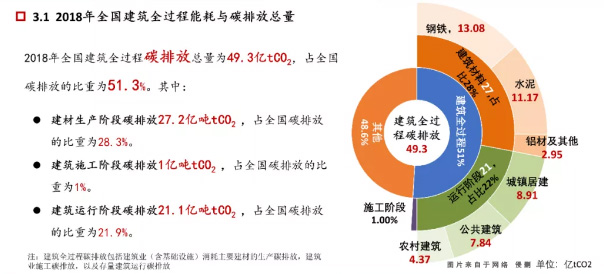On September 22, 2020, at the 75th session of the United Nations General Assembly, China clearly put forward for the first time the long-term goal of "achieving carbon peak by 2030 and achieving carbon neutralization by 2060".
Under the general trend of carbon neutrality, it not only challenges the rapid transformation of various industries in the market, but also symbolizes that there are greater opportunities waiting for us!
Reducing building energy consumption is an important way to achieve carbon peak and carbon neutralization.
The Party's 14th five-year Plan and the outline of the long-term goals of 2035 point out that we will promote clean, low-carbon, safe and efficient use of energy, and further promote low-carbon transformation in industry, construction, transportation and other fields.
Among them, the construction field should be a big energy consumer!
According to the China Building Energy consumption Research report (2020), from 2005 to 2018, the energy consumption of the whole building process in China increased from 934 million tons of standard coal in 2005 to 2.147 billion tons of standard coal in 2018, an increase of 2.3 times, with an average annual growth rate of 6.6%, with a significant increase.
It can be seen that the low-carbon transformation in the field of construction is imminent!

The first step to solve the problem is to find out the problem, so what is the primary reason for such a large amount of carbon emissions in the construction sector?
In fact, there are nothing more than these three points: large stock, new increase, and high emissions!

Large stock.
China is the largest country with existing buildings in the world, and the carbon emissions in the field of construction account for a large proportion.
According to the data of the National Bureau of Statistics, the total stock of urban buildings in China is about 65 billion square meters, and many existing buildings have the current situation of high energy consumption and high emission.
In this way, the transformation of existing buildings will become a huge gap in demand, but also a rare opportunity!
To meet this demand, the replacement of energy-saving doors and windows in a large area is undoubtedly a very direct and effective solution.
As the weakest link of the building, doors and windows are called the black hole of building energy consumption. The energy lost through doors and windows accounts for as much as 45% or 50% of the building energy consumption, which shows the importance of energy-saving doors and windows!
It can be seen that the demand market is huge!

New increase.
According to the data of the National Bureau of Statistics, the area of new housing construction in China in 2020 is 2.24433 billion square meters, down 1.2% from the previous year, but its increase can not be ignored!
In addition, according to the Action Plan for the creation of Environmental Protection buildings issued by the Ministry of Housing and Urban-Rural Development and the National Development and Reform Commission in July 2020, by 2022, the proportion of green buildings in new urban buildings will reach 70%. Star environmental protection buildings continue to increase, the energy efficiency of existing buildings continues to improve, residential health performance continues to improve, and the proportion of assembly construction steadily increases.
The scope of application of environmentally friendly building materials has been further expanded.
Various localities have issued relevant documents one after another to clarify the development goals of environmentally friendly buildings.
It can be seen that there are many development opportunities in projects such as environmentally friendly buildings and passive ultra-low energy consumption buildings.

No matter what kind of building form, in order to achieve a small amount of carbon emissions, it is absolutely impossible without the addition of energy-saving doors and windows, and special installation technology is needed to maximize the overall sealing performance and energy-saving effect of the building. reduce the carbon emissions of the building in the process of operation!
High emission.
According to the China Building Energy consumption Research report (2020), the total energy consumption of the whole building process in 2018 was 2.147 billion tce, accounting for 46.5% of the country's total energy consumption.
In 2018, the total carbon emissions of the whole process of construction in China was 4.93 billion tCO2, accounting for 51.3% of the national carbon emissions.

From the proportion of the total carbon emissions in the whole process of the building, it is not difficult to see that if we want to achieve the peak of carbon dioxide emissions by 2030 and achieve the goal of carbon neutralization by 2060.
To improve the energy efficiency of buildings is an imperative and powerful measure!
Door and window energy saving is the key to building energy saving.
It is not difficult to find that whether it is the renovation of old houses or the construction of new houses, energy-saving doors and windows are an indispensable part!
At present, the more popular type of energy-saving doors and windows in the market is aluminum-clad wooden windows, and the same is true when it comes to passive near-zero energy consumption buildings!
In the long run, high-quality aluminum clad wood window has better application value and social benefits, its unique wood-aluminum composite frame + hollow glass structure, but also can greatly improve the sealing, waterproof and other properties of the whole window, through the frame with low thermal conductivity and barrier part of purple and infrared low-e film glass, reduce the indoor cold and heat energy transmission velocity.
Recently, local governments have issued a large number of policies to encourage the widespread use of passive ultra-low energy consumption buildings, while issuing corresponding standards to improve the degree of energy saving and emission reduction of construction products.
In this way, the demand for aluminum-clad wooden windows in the field of environmentally friendly construction will also rise in a straight line!
Sayyas was founded in 1998, always adhering to the "limit consumption reduction extremely beautiful life" corporate mission!
For more than 20 years, with the research and development and manufacture of high-performance and energy-saving aluminum-clad wood windows as our responsibility, we aim to achieve the corporate vision of "using windows to block climate change" by bringing energy-saving aluminum-clad wood window products into more families.
So far, Sayyas has provided aluminum-clad wood window products for tens of thousands of families, and has received consistent praise, and has completed nearly 100 passive ultra-low energy consumption buildings, with cooperative franchisees in major first-tier, second-tier and third-tier key cities across the country.
At the same time, Sayyas is also launching a high-quality franchisee recruitment program across the country to explore the future of energy-saving aluminum-clad wooden windows and buildings!
Tel.
400-6700-999
Address
Address of Shuangcheng factory:
Crossroads of Songhuajiang Road and Xing'an Road, New Industrial Park, Shuangcheng Economic Development Zone, Harbin
Address of Haxi factory:
No. 9, Xinnong Road, Nangang District, Harbin
Address
Address of Nanjing factory:
No. 18, Zhonghuan Road, Jiangning District, Nanjing
Address of Nanjing office building:
Building F, Shimao 52 +, Yuhua District, Nanjing
JD official flagship store

Tmall official flagship store
